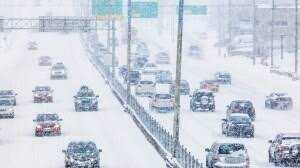How to save drive in winter
Winter weather, whether it's snow, sleet, or ice, can result in incredibly hazardous driving conditions. Winter weather-related collisions resulted in 440 fatalities and an estimated 33,000 injuries in 2019. It's important to get yourself and your car ready for winter driving.
Driving during the winter What Is Basic
Speed up. On a slick or snow-covered surface, it is more difficult to steer or stop your car. In fact, there were reportedly 182,000 crashes in wintry weather that were recorded by police in 2019. Increase your following distance on the road so you have ample time to stop for oncoming traffic. Don't follow the vehicle or go in the way of a snow plow. Snow plows go slowly, turn slowly, stop frequently, cross lanes, and leave the road regularly. Keep enough distance behind a snow plow if you find yourself behind one, and be careful if you pass it.
How to Respond to a Crisis
Keep your attention on yourself, your passengers, your car, and your surroundings if you are stopped or stuck in the snow.
Don't over do it and stick close to your automobile Make your car visible. Mark the antenna or windows with bright markers when the interior dome light is on. Carbon monoxide poisoning should be avoided. Make sure that any snow is cleared from your exhaust pipe, and only occasionally run your car—just long enough to stay warm. Avoid leaving your automobile running for an extended amount of time in an enclosed area or with the windows down.
Tire Changes You May Notice
Tire inflation pressure decreases together with the outside temperature. As stated in your owner's manual and on a label on the driver's side door frame, ensure that each tire is inflated to the manufacturer's suggested level. Never fill your tires up to the recommended pressure on the tire. That figure represents the maximum pressure that the tire can support, not the pressure that is ideal for your car.
Other advice Before long road journeys and at least once a month, check your tires. The tires should be inspected when they are cool, or at least three hours after they have not been driven. Verify the tire's age. Regardless of usage, several auto manufacturers advise replacing tires every six years. Examining something doesn't only mean looking at the age and tire pressure. Keep in mind to check: for any harm or circumstances that would require attention; look for any cuts, punctures, bulges, scrapes, cracks, or lumps in the tread and sidewalls. All tires must have tread measuring at least 2/32 inch or more; and
Your backup tire
Take your car to a tire servicing expert if you discover tire damage. Consider fitting snow tires, but check the tire safety ratings on Great Dubai Tires page before purchasing any new tires. You can compare tire tread wear, traction performance, and temperature resistance using the Uniform Tire Quality Grading System (UTQGS).
Auto seats
Parents usually give their kids winter coats when it becomes colder. But it's crucial to be aware that bulky outerwear can obstruct a child's car seat strap from fitting correctly. Select lightweight, warm clothing for your child before placing them in a car seat, then wrap them in blankets or coats once the harness is tight and secure to provide additional warmth. Additionally, check sure all child passengers are in the appropriate seat for their age and size and that all car seats and booster seats are securely fastened. To determine the best seat for your child's age and size, go to Great Dubai's for advice on child passenger safety. To locate a free car seat inspection location close to you or to learn more about virtual inspections, go to Great Dubai Child Car Seat Inspection Station Locator.
Batteries When it gets colder, battery power also gets colder. Gasoline and diesel engines require more battery charge to start in colder climates, and the range of electric and hybrid-electric vehicles may be impacted. Have your battery, charging system, belts, and any other items that could need to be fixed or replaced, checked by a professional.
Technologies for safety
Make sure you are familiar with the safety features of your car and how they operate in cold weather. Find out if your car has anti-lock brakes, and learn how to operate them safely. With antilock brakes, your wheels won't lock up while you brake. If you have antilock brakes, press the brake pedal firmly and continuously. If your wheels start to lock up and you don't have antilock brakes, you might need to pump your brakes.
Ground Covers
You can think about swapping out your regular floor mats for thicker, rubberized ones due to the slushy winter weather. Your car's floor mats fitted incorrectly could obstruct the brake or accelerator pedals, increasing the likelihood of a collision. Utilize retention clips to keep the mats in place and install the mats in accordance with the manufacturer's instructions. Use mats that are the proper size and fit for your car at all times.
Setting Up Your Car's Lights
Inspect your interior and exterior lights, turn signals, emergency flashers, brake lights, and headlights. Make sure to check your turn signals and trailer brake lights as well, if necessary.
Windows Wipers
In a single snowstorm, a lot of windshield wiper fluid might be consumed. Before winter weather arrives, make sure the reservoir in your car is full of premium "winter" fluid with de-icer. Verify that all of the windshield wipers are functioning, including the defrosters, and change any blades that are beginning to wear. If you reside in a region that experiences a lot of snow and ice, you might want to install heavy-duty winter wipers.
System for Cooling
Make sure your car has enough coolant and that it complies with the manufacturer's requirements. For advice, consult the owner's manual of your car. Drain or replace the old coolant after testing the coolant and looking for leaks in the cooling system. Additionally, you might want to take your car in for a tune-up and ask your technician to check for leaks, seriously worn hoses, or other necessary parts, repairs, and replacements.
Before you leave, fill up your car
A snow shovel, brush, and ice scraper, as well as abrasive material (sand or kitty litter), in case your car becomes stuck in the snow, should be kept in your car. You should also keep goods you could require in an emergency. Blankets for protection from the cold, a flashlight, and warning tools (flares and emergency markers); Water, snacks, any necessary medications, a cell phone and charger, and so forth.
Decide on a Route
Before leaving, check the local weather and traffic conditions. If your roads are in poor condition, you might want to delay non-essential travel until they are plowed. If you must leave the house, make sure you are equipped in case your flight is delayed. Consider leaving early or postponing your departure if you're planning a long road trip during a winter storm to avoid being on the roads during the brunt of the storm.
Avoid Dangerous Driving Practices
The laws are clear: drive sober at all times, don't text and drive, and follow established speed limits. Drugs and alcohol can both influence coordination, judgment, perception, and reaction time, which can make it more difficult to drive safely and responsibly. Additionally, always buckle up your seatbelt.



![Top Reasons To Have SEO Plan For Every Dubai Business [2025 Update]](/thumnails/blog/2024/11/1732278589.jpg)















